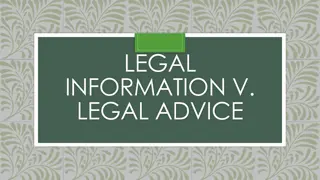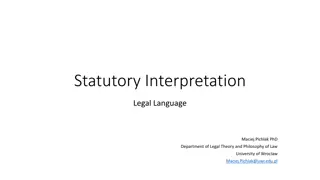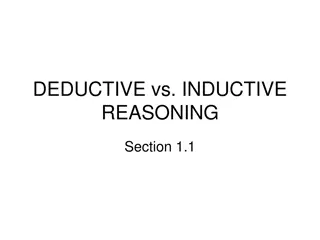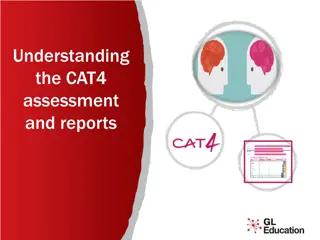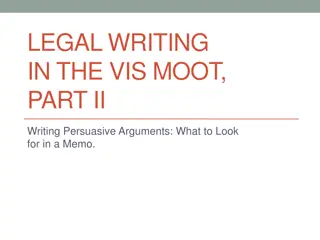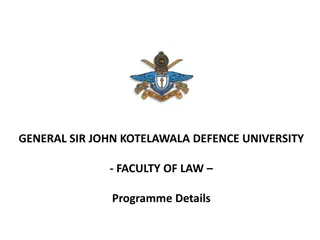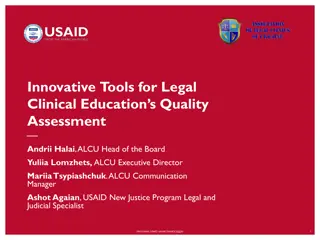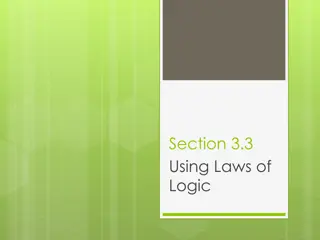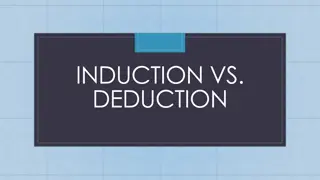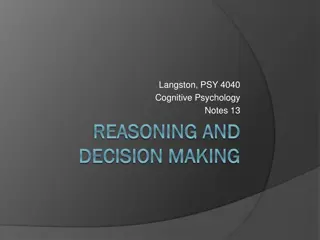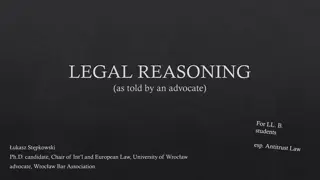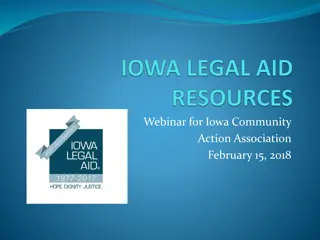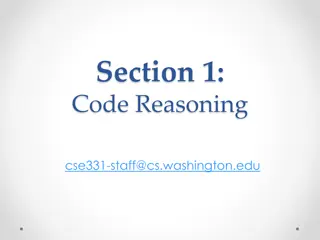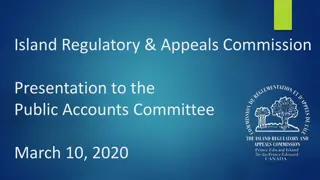Understanding the FILA/IRAC Format for Legal Reasoning
Explore the FILA/IRAC format for writing legal documents, learn to identify correct and incorrect examples, and understand how to apply this format in problem-solving scenarios. The lecture introduces the basics of legal reasoning, focusing on the essential components of Facts, Issues, Law/Rule, Application, and Conclusion (FILA/IRAC). Get insights on how to approach problem questions and provide advice using this structured format.
Download Presentation

Please find below an Image/Link to download the presentation.
The content on the website is provided AS IS for your information and personal use only. It may not be sold, licensed, or shared on other websites without obtaining consent from the author. Download presentation by click this link. If you encounter any issues during the download, it is possible that the publisher has removed the file from their server.
E N D
Presentation Transcript
Module 2: The Basics of Legal Reasoning LAW1231: Lecture 4 The FILA Format
Introduction Introduction At this stage in your career, you are expected to use a particular format for answering problem questions. A problem question is one in which you are given a fact scenario and asked to provide advice. As you progress, you will discover that the same format is used for writing submissions, legal opinions/memoranda, and judgements. We will therefore look closely at what is involved in writing based on the preferred FILA / IRAC format for writing legal documents.
Learning Outcomes Learning Objectives By the end of this lecture, students will be able to: Explain the FILA/IRAC format Identify correct and incorrect examples of the writing the Law/Rule
A Problem Question Oh , no Tom! The tractor! Tom Piperson commandeered Farmer Brown s tractor in order to chase his (Tom s) escaping piglet. Unfortunately, Tom accidentally permitted the tractor to roll off a cliff. Stop, You THIEF! Officer Blue the policeman has now charged Tom with theft. Advise Tom.
Where do we start? Identify the parties: The State (represented by Officer Blue) Farmer Brown Tom Piperson Identify the possible lawsuits: 1. Option #1: The State v Tom: Is Tom guilty of theft? 2. Option #2: Farmer Brown v Tom: ? Trespass to property? 3. Option #3: Farmer Brown v The State? The State v Farmer Brown? Tom v The State? Tom v Farmer Brown? In this case, we are expressly asked to consider The State vs Tom in relation to Theft.
What Should We Do? Steps to Take 1. Explain the Relevant Law including any ambiguities in the law What exactly is Theft? Is it defined in the law? We need to know what the law is before we can decide whether it has been broken 2. Examine the Facts to see if there are any ambiguities, and to see whether the law has been broken 1. Option #1: What Tom did falls into the definition of theft 2. Option #2: What Tom did does not fall into the definition of theft 3. Provide the advice requested
What is FILA/IRAC? What we have just described is the outline of FILA/IRAC. FILA stands for Facts, Issues, Law, Application IRAC stands for Issues, Rule, Application, Conclusion. There is really no difference between the two, and I prefer to combine them as FIR/LAC. FIR/LAC = Facts, Issues, Rule/Law, Application, Conclusion TIP: You are free to use any of the above. Just remember that you do not have to rewrite the facts when you are answering problem questions, and that you always have to give a conclusion.
What is R/L? As mentioned, the Rule/Law section is a mini-essay on the law. It should explain the relevant law in the area with specific reference to statute and precedent where appropriate, and highlighting any ambiguities. It should not make any reference to the parties or the facts of the case.
What R/L is NOT There may be times that you are tempted to take shortcuts. R/L should NOT be: 1. Simply stating the name of a statute 2. Simply stating the name of a case 3. Copying and pasting the text from the statute 4. Copying and pasting the text from the case
Answering the Question The State v Tom: We are told that the State has charged Tom with theft. Before we examine his innocence or guilt, we first examine the law related to theft. We do this in the form of a short essay. This discussion of the law is completely independent of the facts in the fact scenario.
The (Fictitious) Law Related to Theft For the purposes of this example, we draw from the description of the law given in Lecture 1. The Barbados Theft Act, Cap 155 A person who dishonestly appropriates property belonging to another with the intention of permanently depriving the other of that property is guilty of theft and liable on conviction on indictment to imprisonment for 10 years
Remembering Sources of Law Remember that we explained in Lecture 1 that common law is made up of both statute and precedent. Judges have a role to play in interpreting the law, and they are obliged to consider the cases which came before.
The (fictitious) Law Related to Theft In Lecture 1, we were given further (fictitious) information about the Theft Act: High Court Judge Alpha J gives specific interpretations of the words appropriate and permanently in the case R v Fagin. Fagin is unhappy with the outcome and appeals to the Court of Appeal in relation to the definition of the word permanently . The Court of Appeal agrees with Fagin and reverses the decision of Alpha J. So we have a precedent (R v Fagin CA)which establishes meanings for appropriate and permanently .
Constructing A Mini-Essay on the Law STEP 1: Describe the Statute & Precedent: Our discussion of the Law must therefore include not only the Statute, but also the precedent. We must describe both. Than also explain whether there are any further developments or other ambiguities. Example: Mini-Essay 1st Describes the Statute/ Law The Barbados Theft Act Cap 155 defines theft as dishonest appropriation with intention of permanent deprivation. The term appropriate was explained by Alpha J (with whom the Court of Appeal agreed) in the case R v Fagin [citation]. In that case, the defendant Fagin had .... The court considered ... and concluded that appropriation did not include annexation .
Constructing A Mini-Essay on the Law STEP 2: Identify an Ambiguities in the Law Just as with the example of writing , there will often be a word whose meaning might have more than one interpretation in the law. See if the same applies here. Example of Ambiguity Found in the Law In the scenario given, the word which was used was not appropriating but commandeering . Does this make a difference in respect of the Theft Act?
Constructing A Mini-Essay on the Law STEP 3: Show both sides of the ambiguity If we find an ambiguity in the law, then we need to show both possibilities. Example of Discussing the possible interpretations On the one hand, the word commandeer , as defined by the Oxford dictionary, has a similar meaning to appropriate . On the other hand, the Oxford dictionary further states that commandeer generally has a military connotation.
STEPS TAKEN TO ANALYSE THE LAW What Was Done To Analyse The Law Notice very carefully what we did there: We used statute and precedent where appropriate to show the appropriate RULE. We showed both sides of the ambiguity.
Recap Steps Holistically Taken To Analyse The Law What we have just looked at are the first three steps in answering problem questions: 1. We considered the FACTS the Scenario, also called the Fact Pattern 2. We identified the ISSUES the legal question to be asked and any ambiguities 3. We wrote a mini-essay on the LAW which explains the appropriate RULE. In our next class, we will consider how to APPLY the law, and how to write a CONCLUSION.
Example Problem #2 Let us return to our previous example about writing to show FILA/IRAC in action. Vicky Vendor has offered for sale her 7,000 sq ft property at Doubles Drive, Diego Martin, Trinidad. The cost is $400,000. Pat Purchaser goes to view it and sends Vicky a Whatsapp message saying, I will buy the land. Vicky Whatsapps her back saying, Sounds good. Unfortunately Vicky dies soon after. Vicky s two sons no longer want to sell the land. Advise Pat.
Problem #2: Sample Answer Issue: Was the contract in writing? The Law The law in this area is governed by the Conveyancing and Law of Property Act Chap 56:01 of Trinidad and Tobago which provides at section 4 that all contracts for the sale of land must be in writing and signed by the party to be charged.
Problem #2 : Sample Answer Cont d It is noteworthy that while the Act contains a definitions section at section 2, the words writing and signed are not defined. These definitions are therefore open to judicial interpretation and the Court may take into consideration the fact that with the advent of modern technology, electronic communication is now almost as prevalent as paper communication.
Problem #2 : Sample Answer Cont d Indeed, the Court of Appeal in New York recently stated Given the now widespread use of email as a form of written communication in both personal and business affairs, it would be unreasonable to conclude that email messages are incapable of conforming to the criteria of [New York law] simply because they cannot be physically signed in a traditional fashion. --Forcelli v. Gelco Corporation 2013 NY Slip Op 05437 (N.Y. App. Div. July 24, 2013) It is suggested that this statement is reasonable, and is likely to be adopted by the Trinidadian court.
Required Resources Required Resources Readings & Resources (Required) Virtual Library Tour (video by lecturer) to be provided later by the lecturer.
Learning Activity 4.1 Discussion Forum Learning Activity Ungraded 4.1 Instructions: You are asked to provide and answer to the following question in an appropriate discussion forum on the Learning Exchange. You may comment on what your peers have posted. 1. What was the muddiest point in the lecture? _______________________
Learning Activity 4.2 Pop Quiz on the FILA format Learning Activity Ungraded 4.2 Pop Quiz On the FILA FORMAT Instructions: Please see a link to the lecture note 4 pop quiz which will be provided on the Learning Exchange.
Summary of Lecture Note 4 Summary In this lecture, we have looked at the first part of answering problem questions a mini-essay on the RULE and we learned the following: It is in the RULE section that you introduce any legislation and cases, It is here that you identify any relevant changes or challenges in the law, and It is important to remember that your mini-essay must be brief and to the point you are answering a problem question and not an essay question. You will need time to discuss the other issues. However, do not be too brief as you still need to mention all of the critical points.



